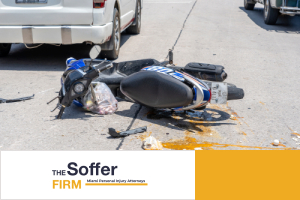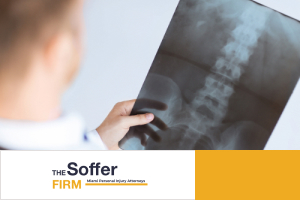Motorcycle accidents can happen in an instant. If you or a loved one has been injured in a motorcycle accident, it’s essential to know the most common motorcycle accident injuries and what can be done to help them heal faster.
The majority of motorcycle accidents are caused by other vehicles on the road, so knowing how to avoid these types of collisions is essential for motorcyclists.
Most serious injuries sustained that occur during a motorcycle crash are due to impact with another vehicle involved in the collision (not from hitting the ground). Knowing this key fact will allow motorcyclists to prepare themselves for potential injury prior to an accident occurring.
In addition, knowing how best to treat these most common injuries will help motorcycle riders recover faster and keep them riding sooner than if they didn’t know what was wrong with their bodies.
Most Common Types of Injuries in a Motorcycle Accident
The are many sorts of fatal injuries a motorcyclist may suffer in an accident, but certain problems are more prevalent. The following are some of the most frequent motorcycle accident injuries:
Spinal cord & back injuries
In the event of a common motorcycle crash, riders can suffer severe back and spinal cord injuries, including fractured vertebrae. Surgery, physical rehabilitation, and time away from work are all common treatments that may be given to motorcyclists suffering from back injuries.
Damage to the spinal cord might result in paralysis below the site of the trauma.
Fractures & broken bones
Broken bones are quite the common injuries suffered among bike riders. Whether the rider is injured in a motorcycle accident because of their own driving or in a collision with another vehicle, they’re likely to suffer fractures.
Riders frequently damage their hands, arms, feet, legs, and ribs. The severity of the fractured bones depends on the circumstances; nevertheless, healing might require surgery and physical therapy.
Traumatic brain injuries (TBI)
Unhelmeted riders, or even helmeted riders, can suffer from a traumatic brain injury, which can range from mild to severe injuries.
The minor brain damage might be quickly overcome, but moderate to severe TBIs frequently have long-term repercussions, including cognitive and physical impairments as well as permanent nerve damage. A severe TBI can cause a coma and death.
Road rash or burn
The phrase “road rash” refers to abrasions and lacerations a motorcyclist gets from sliding on pavement or gravel. It’s a typical accident for motorbike riders, with minor to severe degrees of severity.
A first-degree road rash causes reddening of the skin, but victims do not necessitate medical attention other than home care.
A second-degree road rash requires more care since a person suffering from this usually has broken skin. Although most of the time, this does not necessitate someone to be rushed into the emergency room.
A third-degree road rash is a severe type. This affects multiple external skin layers. A third-degree road rash should be treated as soon as possible to minimize the chance of infection. Motorcyclists should wear the proper gear to protect themselves better against road rash.
Internal organ damage
Motorcyclists’ internal organs can likewise be damaged in a collision, particularly in accidents involving multiple vehicles.
For instance, when a passenger vehicle strikes the motorcyclist from behind, blunt force impact to vital organs is common. Side impacts and ejected riders might also suffer injuries due to contact with another car or pavement. Injury to the internal organs can result in death if no immediate medical attention is done.
Head & neck injuries
Non-fatal motorcycle injuries to the head and neck are quite prevalent. Riders can suffer from whiplash, which can damage the muscles and ligaments in the neck or cause paralysis. The neck, face, and skull are all possible sites of head and neck injuries.
In addition, the motorcycle rider is more likely to suffer permanent scarring, severe head trauma, or head injuries such as scalp lacerations if they do not wear a helmet.
Leg & feet injuries
The lower extremities such as legs and feet are the most frequently affected areas in non-fatal motorcycle accidents. This may be due to a rider’s legs being frequently struck in a collision or because they are the first body parts to strike the ground if they fall to the side.
Broken bones, dislocations of the knees, and road rash are all examples of leg injuries. Riders should use protective gear like boots and a robust, thick cloth on their legs to prevent these kinds of accidents.
Face & dental injuries
Areas in the face and mouth are very susceptible to catastrophic motorcycle accident injuries. Eye damage or loss of vision, fractured facial bones, loose or missing teeth, permanent facial scarring, and other problems may be experienced by the victims.
Dental and facial injuries caused by automobile accidents may cause disfigurement, lowering a victim’s self-esteem and confidence.
Chest injuries
The chest is often injured in common motorcycle crashes. Broken ribs, organ damage, collapsed lungs, and internal bleeding are all possible consequences of blunt force trauma to the chest.
Chest injuries are often serious and may require surgery. If not treated quickly, they can lead to death.
Open wounds
Motorcycle accidents often leave the victims with open wounds which can be caused by road rash, broken bones piercing the skin, or a sharp object.
Open wounds, like those that occur from shrapnel or splinters, might be contaminated by dirt, shards of metal or glass, or other debris and therefore need expert debridement. Open wounds also put people at risk of getting infections.
Motorcycle Accident Victims May Suffer From Long-Term Impairments or Disabilities
Injuries to limbs or upper extremity injuries can limit a person’s physical capabilities. A serious injury to the lower extremities such as an arm or leg might prevent someone from performing high-level activities for long periods of time. Or perhaps entirely stop them from doing so due to permanent disability. And this can also lead them to lost wages or future earning capacity.
Many of the consequences of a traumatic brain injury might make it difficult for someone to live on their own. A person’s brain may be damaged, affecting their sensation, feelings, thinking capacity, and communication skills.
TBI patients who can no longer balance adequately are less likely to get back on their bikes. Changes in personalities, such as depression or aggressive behavior, may be noticed by their friends and relatives. They may have trouble speaking or communicating effectively. TBI victims might also have permanent memory difficulties.
As a motorcyclist, it is important to be aware of the most common injuries sustained in motorcycle accidents. By knowing what to look for, you can seek treatment sooner and have a better chance of making a full recovery. Contact us so we will be able to advise you on your legal rights and help you get the compensation you deserve for a free consultation.
Reach Out to Our Experienced Motorcycle Accident Lawyer If You Suffered From Catastrophic Motorcycle Accident Injuries
Call the experienced motorcycle accident lawyer at The Soffer Firm Miami Personal Injury Attorneys if you have been injured in a motorcycle accident because of someone else’s negligence. We are a prominent and well-respected law firm in Miami that handles all sorts of personal injury cases.
Our skilled personal injury attorneys in Miami are 100% dedicated to safeguarding the rights of those who have been harmed by someone else’s negligence. We recognize the proof required to show the defendant’s bad conduct and how to prove to a judge or jury that the negligent behavior was responsible for your specific injuries.
Our personal injury attorney will fight to get you the maximum compensation available. Call us at 786-788-7344 for a free consultation or email us at info@sofferfirm.com.
“We don’t get paid until you get paid.”













